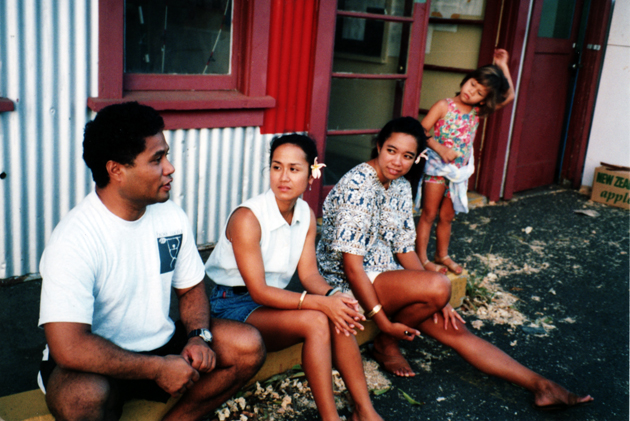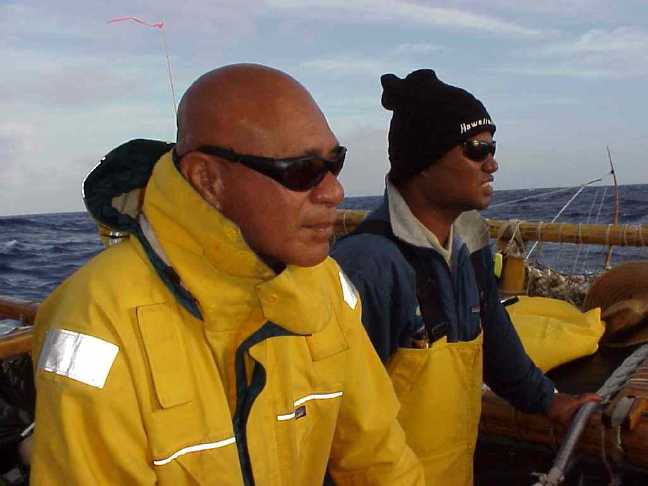Chad Baybayan
Chad aboard Hokuakala‘i, with Kaimana Barcase, 2007.
Notes 2010: Kalepa Baybayan has sailed on Hokule‘a since 1975, when he was nineteen. Since then, he has served as captain and navigator for eight Hokulea voyages, as well as trips on two other wa‘a, Hawai‘iloa and Hokualaka‘i. He is currently the Navigator-In-Residence at ‘Imiloa Astronomy Center located in Hilo and serves as captain and navigator of Hokualaka‘i ("Guiding Star"), a 58-foot canoe launched in 2004 and operated by 'Aha Punana Leo, an educational organization dedicated to perpetuating Hawaiian language and culture.
Interview and Photo by Sam Low (2000)
Chad Baybayan stands about five feet eight inches. He has a swimmer's body, suggesting a capability of delivering powerful strokes and a strong finishing kick. He is dark both by genetic makeup (he is part Hawaiian, part Filipino) and because he spends a lot of time in the sun attending to his duties as one of Hokule'a's navigators. Chad will readily tell you that voyaging aboard the canoe has been the seminal experience of his life - accounting for the fact that he is about to receive a master's degree in education, for his happy marriage and fatherhood, for his inner sense of confidence.

Chad, 2000 Voyage to Rapanui. Photo by Sam Low
"When I first saw Hokule'a in 1975, it just grabbed my heart. I knew that if there was anything in my life that I wanted to do it was sail on her."
For a time, it appeared that Chad's wish might not happen. Chad was too young for the 1976 voyage to Tahiti. In 1978, when the canoe swamped on a second journey, it looked like voyaging might end. But shortly thereafter, new management took over the Polynesian Voyaging Society and Baybayan spent countless hours working with sandpaper and paintbrush, helping to overhaul the canoe for another voyage. In 1980 he made his first ocean passage to Tahiti as the "youngest member of the crew" and began to study navigation by "asking Nainoa Thompson (the canoe's navigator) a lot of questions."

Chad, 1980. Photo by Mike Tongg
During the next nineteen years he spent as much time as he could afford aboard the canoe, eventually working his way up the informal hierarchy to full fledged navigator.
Among Hokule'a's navigators (there are three other fully qualified ones - Nainoa Thompson, Shorty Bertelmann, Bruce Blankenfeld), Chad may be the most charismatic, and it is for this reason that he is often chosen to be the Voyaging Society's spokesman. So it was that one evening in May of 1999 (98?), Chad stepped forward to talk to crew candidates for the upcoming voyage between Hawaii and Rapa Nui. The men and women assembled before him were about to go through a final four day training session that would include an open ocean swim of nearly two miles, a sail aboard Hokule'a, and many hours of testing their navigation and seamanship skills. They all knew each other well. Most of them, excluding a few young rookies, had sailed on previous voyages during the canoe's twenty-five year career.
"You are all here because you share a powerful vision for Hawaii," Baybayan told them. "And that vision joins you together across differences in ethnicity and race and where you may have been born and raised. You share a common desire to make this world better."
Baybayan's notion of ethnic and racial unity was not always a part of the voyaging consciousness. The early 1970s marked a cultural revival among Hawaiians that inspired not only pride but also renewed painful memories of a history marked by near genocide, loss of land, and culture. The times were ripe for sectarianism. On the first voyage to Tahiti in 1976 - a near mutiny was inspired by some crewmembers who felt that only authentic Hawaiians, as they defined it, should be allowed aboard the canoe. But now, almost twenty-five years later, seated before Baybayan were men and women of many extractions - Chinese, Filipino, Japanese, Hawaiian, Portuguese, German, English, American. They had shared hundreds of hours working together during which potential differences between them had come to mean not a whit.
Confronting the sea on long voyages, Chad has had much time to integrate all that he has learned and he has done so by bundling an astonishing number of lessons into a general philosophy that he (and the other sailors and navigators as well) calls "wayfinding."
Chad distinguishes wayfinding from navigation - the technical art of finding land without the use of instruments or charts. He will tell you that wayfinding is "a way of organizing the world." He has also said that it's "a way of leading," "of finding a vision," "a set of values," "how to take care of the earth," and, in general, "a model for living my life."
Chad's vision of wayfinding eventually evolved to contain principals that appear astonishingly universal and timeless, while, at the same time, being rooted in values that Hawaiians have come to recognize as inherent in their own unique history. Values like vision, for example.
"Our ancestors began all of their voyages with a vision," Baybayan explained during his talk to the assembled crew. "They could see another island over the horizon and they set out to find these islands for a thousand years, eventually moving from one island stepping stone to another across a space that is larger than all of the continents of Europe combined."
"After many years, I began to understand that wayfinding was really a model for living," Chad continued. "Once you have the vision of a landfall over the horizon, you need to develop a plan to get there, how you are going to navigate, how much food you need. You must evaluate the kinds of skills you need to carry out the plan and then you must train yourself to get those skills. You need discipline to train. Then, when you leave land, you must have a cohesive crew - a team - and that requires aloha - a deep respect for each other. The key to wayfinding is to employ all these values. You are talking about running a ship, getting everybody on board to support the intent of the voyage, and getting everybody to work together. So it's all there - vision, planning, training, discipline and aloha for others. After a while, if you apply all those values, it becomes a way of life."
Chad Baybayan's concept of wayfinding is not exclusive to him. It is, in fact, a voyaging subculture shared by everyone who is attracted to the canoe and who sticks around long enough to learn the lessons it has to teach.
In the last decade or so, the philosophy of wayfinding has "moved ashore" so to speak. New words have entered the wayfinding vocabulary, "stewardship" for example, or "sustainable environments." Lessons learned at sea are now being applied to the land. The ancient philosophy of wayfinding is now merging with the new world view of environmentalism, as Chad explains:
"To be a wayfinder, you need certain skills - a strong background in ocean sciences, oceanography, meteorology, environmental sciences - so that you have a strong grounding in how the environment works. When you voyage, you become much more attuned to nature. You begin to see the canoe as nothing more than a tiny island surrounded by the sea. We have everything aboard the canoe that we need to survive as long as we marshal those resources well. We have learned to do that. Now we have to look at our islands, and eventually the planet, in the same way. We need to learn to be good stewards."
This new vision is at the core of the Voyaging Society's "Malama Hawaii" program which we celebrate on this voyage home.
"At the beginning of this new millennium, we honor the first 25 years of Hokule'a's life and the achievements we've all realized working together," Nainoa writes in an open letter on this web site. "Since 1975, the canoe has sailed more than 90,000 miles, taking us to each of the points of the Polynesian Triangle. We've learned a lot during these voyages--the power behind shared vision, the energy generated through collaboration, the continuing thrill of exploration and discovery and the joy of kinship."
"But by far, the most compelling lesson we've learned in all of our travels has to do with home. We've come to appreciate anew, the uniqueness of Hawaii and her people and our responsibility to work together to maintain that uniqueness."
"Learning to live well on islands is a microcosm of learning to live well everywhere. Here in Hawaii we are surrounded by the world's largest ocean, but Earth itself is also a kind of island, surrounded by an ocean of space. In the end, every single one of us - no matter what our ethnic background or nationality - is native to this planet. As the native community of Earth we should all ensure that the next century is the century of pono - of balance - between all people, all living things and the resources of our planet."
Photos

1985: Chad (far right) with Hector Busby in Aotearoa, on the 1985-1987 Voyage of Rediscovery.
1992: Chad, with PVS administrator Jarnell Martinson and crew member Shantell Ching, outside of PVS office at Pier 35, where the voyaging canoe Hawai‘iloa was built. On the voyage to Tahiti, Chad Baybayan shared navigation duties with Shorty Bertelmann
In 1992, Chad and Shorty Bertelmann were co-navigators on the voyage from Hawai‘i to Tahiti. He says the most difficult part of the voyage was the doldrums, where shifting winds and heavy cloud cover made sailing and wayfinding difficult. The canoe had to tack five times in one day as the wind direction kept shifting. The shifting winds confused the swell pattern. "When you become confused by the swells, you have to confirm your judgment by the movement of clouds on the horizon and the feel of the wind on your body." He estimates he slept only three hours a day on the 29-day voyage. But the voyage was a matter of personal, family, and ancestral pride: "The statement we wanted to make was that we are the descendants of some very courageous and intelligent people."
From 1993-1995, in preparation for the 1995 voyage to Nukuhiva, Chad assisted in the construction and modifications of Hawai'iloa and Hokule‘a drydock. On the voyage to Nukuhiva, he served as co-captain and co-navigator of Hawai'iloa, with Bruce Blankenfeld, from Hawai'i to Tahiti (2,400 miles, 21 days); captain and navigator of Hokule‘a from Tahiti to Nukuhiva; and navigator of Hokule‘a from Nukuhiva to Hawai‘i.
In 1999, he led Hokule‘a on a voyage to the six major islands of the Marquesas then on to Pitcairn and Mangareva before sailing as a member of the navigation team to Rapanui.
1999: Chad (right) with Tava on the Voyage to Rapanui. Photo by Sam Low
After the Voyage to Rapanui Chad worked on building and launching the Hilo canoe Hokualaka‘i, and leading the educational programs for the canoe. In 2006, he sailed around Kaua'i and Ni‘ihau (pdf file) on the canoe, in a tribute to the first Hokule‘a captain Kawika Kapahulehua, who was from Ni‘ihau.

In 2007, he traveled to Satawal to be inducted into pwo by Mau Piailug, along with four other Hawaiian navigators.

Satawal 2007

2007: Shorty, Nainoa, Mau, and Chad. Photo by Sam Low
When Hokule‘a continued on to Japan, Chad captained and navigated her on the legs from Okinawa to Kumamoto; to Nomozaki Nagasaki, and Fukuoka; and to Oshima and Hiroshima.

2007: Captain Baybayan and crew greeting school children. Photo by Kaimana Barcarse




